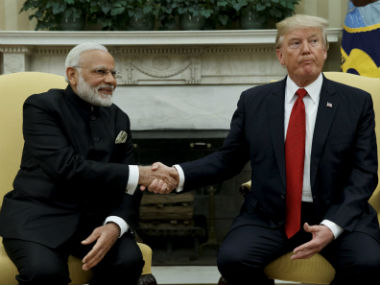High profile meetings of world leaders are normally characterised with photo ops, exchange of antiques and mundane statements that are more generic in nature and less specific on the issues at the moment. Major bilateral decisions — economic or diplomatic — are rarely announced on such occasions.
Narendra Modi-Donald Trump meet was not very different. Both patted each other on the back like ‘true friends’ and said goodbye in style, leaving the media guessing whether this was the beginning of a Modi-Obama like bonhomie or a one-night stand.
In the seemingly budding camaraderie, it was Trump who made a direct demand on the concerns of his side, by asking for the removal of trade barriers to US firms, while Modi missed the opportunity to raise key issues such as H-1B visa restrictions, which have become a pain for the Indian IT-sector.
A look at the joint statements of both Modi and Trump and the half an hour-long press conference of foreign secretary S Jaishankar shows no major promises for Indian economy and Indian companies that have presence in the world’s largest economy by size. Except stressing the growth in domestic aviation sector and the recent Boeing deal by one of the local airlines, Jaishankar largely dodged questions on the H-1B visa issue. Modi too didn’t touch on this subject.
Trump didn’t stick to sugar-coated words all through his statement and was upfront on what he wanted from India in his statement. The Trump key word for Modi to take back home was “fair and reciprocal.”
“It is important that barriers be removed to the export of US goods into your markets and that we reduce our trade deficit with your country,” Trump said. The US had a trade deficit of $20 billion with India for fiscal FY17.
India is a key trade partner for the US. According to official data, total bilateral trade (goods and services) between India and the US increased at a CAGR (compounded annual growth rate) of 11.6 percent from $20 billion in the year 2000 to over $114.9 billion in the year 2016. Goods trade grew at a CAGR of 10.4 percent. During the year 2016, goods trade contributed to 59 percent and trade in services contributed to 41 percent of the total India-US bilateral trade of $114.9 billion.
On the other hand, Modi missed a golden opportunity to raise the visa issue despite the Indians in the US making a pressing case for it (read here). The recent restrictions on work permits imposed by Trump administration has been a big concern for the NRIs in that country. Trump’s policy on foreign workers isn’t anything new. Modi had enough time to work on a prompt way to appropriately pitch this issue during the high-profile meet. But he missed the chance.
Since his campaign days, Trump has warned in no uncertain terms that he will enforce ‘Hire American’ rules that are designed to protect jobs and wages of Americans. That is exactly what he is doing after assuming power. There is a clear strategy to execute the ban involving Departments of Labour, Justice, Homeland Security, which in effect enables the state to take action against fraud and abuse of the US’ visa programmes.
The US issues 85,000 H-1B visas every year. Applications always outnumber the available permits by a big margin. The department issues visas through a lottery system and a good number is secured by Indian nationals. Trump had accused foreigners including Indians for stealing the jobs last year. As this writer said in an earlier article, ‘theft’ is a wrong word for Trump to use, if not an outrageous insult to thousands of Indians and other nationals working for American companies. It was these companies who have reached out to them for cheap labour.
If no American company wanted Indians to be part of their workforce, no Indian would have entered the US soil. The fact is that no one ‘steals’ jobs in the US, but it is purely a play of supply and demand for reasons of efficiency and cost saving. In other words, as much as Indians have benefited from US jobs, the US companies too have gained from accessing cheap labour from India and China.
But, the fact is that for India too much is at stake. The IT sector constitutes at least 10 percent of India’s GDP and much of it is dependent on outsourcing activities for firms in the US and other developed countries. If the US clamps down on hiring foreigners imposing restrictions that are difficult to comply for Indians, Indian IT companies such as Infosys and TCS will have to make fundamental changes in their business models and will see a sharp rise in their employee costs as these firms will be under pressure to hire more Americans.
This will impact their revenues more. It would have been a reassuring act for Indian companies and Indian techies in the US if Modi made a pitch to Trump to take a favourable stance towards the Indian IT sector. But, unfortunately that didn’t happen.
The only tangible outcome of Modi-Trump meet is the promise of stronger ties in fighting terrorism including those emerging from Pakistan. The fact that US chose to designate Syed Salahuddin, chief of Kashmiri militant group Hizbul Mujahideen, as a global terrorist during the Modi visit gives the world a strong signal that the US is serious in aiding India’s fight against extremist group originated and nurtured in the neighbour’s soil.
But, the gains end there. As for economy and businesses, this high-profile meeting was largely a non-event. Trump proved that with the Trump-like statement while Modi chose not to spoil the prospects of a budding bonhomie, like a true friend, by largely keeping silent on crucial issues.



Leave a reply